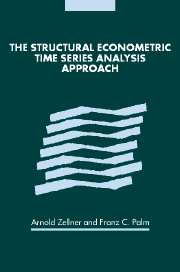Book contents
- Frontmatter
- Contents
- List of contributors
- Acknowledgments
- Introduction
- Part I The SEMTSA approach
- Part II Selected applications
- Part III Macroeconomic forecasting and modeling
- Part IV Disaggregation, forecasting, and modeling
- 20 Using Bayesian techniques for data pooling in regional payroll forecasting (1990)
- 21 Forecasting turning points in metropolitan employment growth rates using Bayesian techniques (1990)
- 22 A note on aggregation, disaggregation, and forecasting performance (2000)
- 23 The Marshallian macroeconomic model (2000)
- 24 Bayesian modeling of economies and data requirements (2000)
- Subject index
- Author index
- References
22 - A note on aggregation, disaggregation, and forecasting performance (2000)
Published online by Cambridge University Press: 24 October 2009
- Frontmatter
- Contents
- List of contributors
- Acknowledgments
- Introduction
- Part I The SEMTSA approach
- Part II Selected applications
- Part III Macroeconomic forecasting and modeling
- Part IV Disaggregation, forecasting, and modeling
- 20 Using Bayesian techniques for data pooling in regional payroll forecasting (1990)
- 21 Forecasting turning points in metropolitan employment growth rates using Bayesian techniques (1990)
- 22 A note on aggregation, disaggregation, and forecasting performance (2000)
- 23 The Marshallian macroeconomic model (2000)
- 24 Bayesian modeling of economies and data requirements (2000)
- Subject index
- Author index
- References
- Type
- Chapter
- Information
- The Structural Econometric Time Series Analysis Approach , pp. 656 - 666Publisher: Cambridge University PressPrint publication year: 2004



